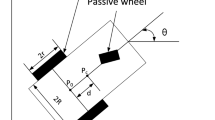Abstract
An adaptive tracking control approach using function approximation technique is proposed for trajectory tracking of Type (2,0) wheeled mobile robots with unknown skidding and slipping in polar coordinates and at the dynamic level. The nonlinear disturbance observer (NDO) is used to estimate a nonlinear disturbance term including unknown skidding and slipping. The adaptive control system is designed via the function approximation technique using neural networks employed to compensate the NDO error. It is proved that all signals of the controlled closed-loop system are uniformly bounded and the point tracking errors converge to an adjustable neighborhood of the origin regardless of large initial tracking errors and unknown skidding and slipping. Simulation results are presented to validate the good tracking performance and robustness of the proposed control system against unknown skidding and slipping.
Similar content being viewed by others
References
J. M. Yang and J. H. Kim, “Sliding mode control of trajectory tracking of nonholonomic wheeled mobile robots,” IEEE Trans. Robot. Automat., vol. 15, no. 3, pp. 578–587, 1999.
D. Chwa, “Sliding-mode control of nonholonomic wheeled mobile robots in polar coordinates,” IEEE Trans. Contr. Syst. Technol., vol. 12, no. 4, pp. 637–644, 2004.
B. S. Park, S. J. Yoo, J. B. Park, and Y. H. Choi, “Adaptive neural sliding mode control of nonholonomic wheeled mobile robots with model uncertainty,” IEEE Trans. Contr. Syst. Technol., vol. 17, no. 1, pp. 207–214, 2009.
T. Fukao, H. Nakagawa, and N. Adachi, “Adaptive tracking control of a nonholonomic mobile robot,” IEEE Trans. Robot. Automat., vol. 16, no. 5, pp. 609–615, 2000.
R. Fierro and F. L. Lewis, “Control of a nonholonomic mobile robot using neural networks,” IEEE Trans. on Neural Networks, vol. 9, no. 4, pp. 589–600, 1998.
S. J. Yoo, Y. H. Choi, and J. B. Park, “Generalized predictive control based on self-recurrent wavelet neural network for stable path tracking of mobile robots: adaptive learning rates approach,” IEEE Trans. Circuit and Systems I. Regular Paper, vol. 53, no. 6, pp. 1381–1394, 2006.
Z. P. Wang, S. S. Ge, and T. H. Lee, “Adaptive neural network control of a wheeled mobile robot violating the pure nonholonomic constraint,” Proc. IEEE Int. Conf. Decision and Control, pp. 5198–5203, 2004.
D. Wang and C. B. Low, “Modeling and analysis of skidding and slipping in wheeled mobile robots: control design perspective,” IEEE Trans. on Robotics, vol. 24, no. 3, pp. 676–687, 2008.
C. B. Low and D. Wang, “GPS-based path following control for a car-like wheeled mobile robot with skidding and slipping,” IEEE Trans. Contr. Syst. Technol., vol. 16, no. 2, pp. 340–347, 2008.
C. B. Low and D. Wang, “GPS-based tracking control for a car-like wheeled mobile robot with skidding and slipping,” IEEE Trans. on Mechatronics, vol. 13, no. 4, pp. 480–484, 2008.
C. B. Low and D. Wang, “Maneuverability and path following control of wheeled mobile robot in the presence of wheel skidding and slipping,” Journal of Field Robotics, vol. 27, no. 2, pp. 127–144, 2010.
X. Chen, S. Komada, and T. Fukuda, “Design of a nonlinear disturbance observer,” IEEE Trans. Industrial Electronics, vol. 47, no. 2, pp. 429–437, Apr. 2000.
X. Chen, T. Fukuda, and K. D. Young, “A new nonlinear robust disturbance observer,” Systems & Control Letters, vol. 41, no. 3, pp. 189–199, 2000.
W. Chen, D. J. Ballance, P. J. Gawthrop, and J. O’Reilly, “A nonlinear disturbance observer for robotic manipulators,” IEEE Trans. Industrial Electronics, vol. 47, no. 4, pp. 932–938, Aug. 2000.
Z. L. Liu and J. Svoboda, “A new control scheme for nonlinear systems with disturbance,” IEEE Trans. Contr. Syst. Technol., vol. 14, no. 1, pp. 176–181, Jan. 2006.
F. J. Lin, P. H. Chou, and Y. S. Kung, “Robust fuzzy neural network controller with nonlinear disturbance observer for two-axis motion control system,” IET Control Theory & Applications, vol. 2, no. 2, pp. 151–167, 2008.
R. Balakrishna and A. Ghosal “Modeling of slip for wheeled mobile robots,” IEEE Trans. on Robotics and Automation, vol. 11, no. 1, pp. 126–132, 1995.
S. J. Yoo, J. B. Park, and Y. H. Choi, “Indirect adaptive control of nonlinear dynamic systems using self recurrent wavelet neural network via adaptive learning rates,” Information Sciences, vol. 177, no. 15, pp. 3074–3098, 2007.
M. M. Polycarpou and M. J. Mears, “Stable adaptive tracking of uncertain systems using nonlinearly parameterized on-line approximators,” Int. J. Control, vol. 70, no. 3, pp. 363–384, 1998.
Author information
Authors and Affiliations
Corresponding author
Additional information
Recommended by Editorial Board member Yangmin Li under the direction of Editor Hyouk Ryeol Choi.
This research was supported by Basic Science Research Program through the National Research Foundation of Korea(NRF) funded by the Ministry of Education, Science and Technology( 2012001440).
Sung Jin Yoo received his B.S., M.S., and Ph.D. degrees from Yonsei University, Seoul, Korea, in 2003, 2005, and 2009, respectively, in Electrical and Electronic Engineering. He has been a Post-doctoral researcher in the Department of Mechanical Science and Engineering, University of Illinois at Urbana-Champaign, Illinois from 2009 to 2010. He is currently an Assistant Professor in the School of Electrical and Electronics Engineering, Chung-Ang University, Seoul, South Korea. His research interests include nonlinear adaptive control, decentralized control, distributed control, and neural networks theories, and their applications to robotic, flight, and time-delay systems.
Rights and permissions
About this article
Cite this article
Yoo, S.J. Approximation-based adaptive control for a class of mobile robots with unknown skidding and slipping. Int. J. Control Autom. Syst. 10, 703–710 (2012). https://doi.org/10.1007/s12555-012-0405-6
Received:
Revised:
Accepted:
Published:
Issue Date:
DOI: https://doi.org/10.1007/s12555-012-0405-6




